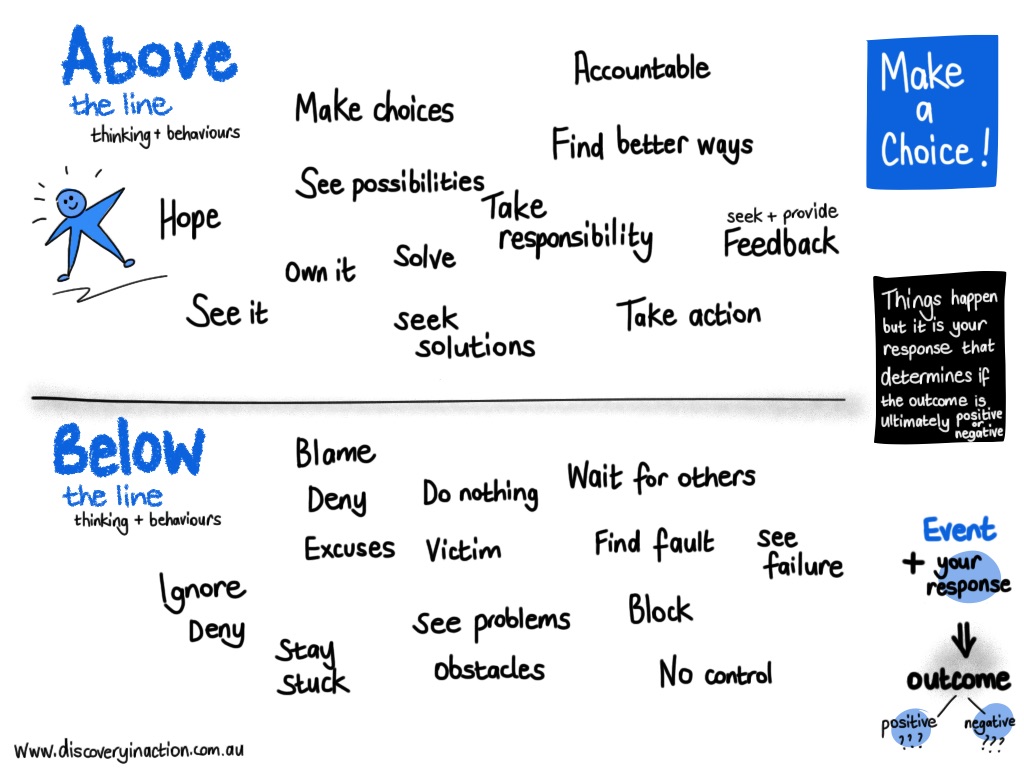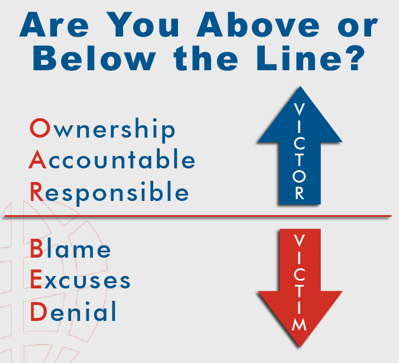If you’re aiming to build your business, leadership is one of those areas where you should constantly be looking to grow and improve. Leadership is an ongoing process and quite often your individual style of leadership will develop as you respond to challenges that arise over time.

Image Source: https://www.discoveryinaction.com.au/latest-news/above-or-below-the-line-where-are-you/
There’s simply no way that your company, diverse as it is and full of conflicting creative goals of individuals, egos and strategic partners, can truly shine if the captain of the ship is not taking the helm as an active leader. Above Or Below The Line … being below will harm your growth, and, in the long term, your lifestyle.
You see, it’s very easy to sit behind the closed doors of your private office, issuing directives via phone or email, lost in your own little world, but the reality is that becoming a ‘leader’ doesn’t occur as a natural function of you taking on the title of ‘Managing Director’ or ‘CEO’. Leadership means being ‘hands on’, involved with your staff and earning the respect and trust of those who are engaged in the ‘doing’ of your company.
I often see in my role as business coach and mentor, organizations whose leaders are shut off from the workings of their company, only appearing to deliver announcements, or to come and go to meetings. Sadly, these leaders are not only missing out on opportunities to grow their company and increase profitability, they’re also losing out on what can be a truly exciting and rewarding journey. Once you finally embrace the fact that you are captain of the ship and have a DUTY to lead, can you REALLY be in control of the direction and ultimate destination of your company. This type of leader does not know if they are Above Or Below The Line …
Leadership is a multi-faceted topic and one which I will come back to in later posts on this blog, however by way of an introduction, let’s take a look at one of the fundamentals of becoming a better leader.
Firstly you should think about who you’re ‘be’ing when you interact with your staff and how you appear to them, your suppliers, your shareholders and the general public.
Here at our business we have a concept of acting ‘below the line’ and ‘above the line’ What this means is that there are certain ways of behaving that affect your organization’s productivity or morale and these types of behavior are either ‘below’ or ‘above’ the line.
Some attitudes characteristic of below the line behavior include playing the blame game, making excuses for why something hasn’t been done, even gossiping in a way that portrays someone in a negative light – in essence, when you’re below the line, you take on the mantle of ‘victim’. Not only is behaving below the line bad for team spirit, it holds an organization and YOU back!
Below the line
Blame, excuses and denial = Being a victim.
Above the line
Accountability, responsibility and ownership = Being a leader.
You’re not being a leader if you blame something or someone else for your lack of success. I hear this type of excuse frequently when leaders of organisations blame the economy, their competitors, the government or some other external factor for their low profits or shrinking customer base.
You are being a leader when you take the reins. By all means factor in external pressures/challenges when looking to grow your business, but don’t become a slave to them! Rather than blame the economy for a downturn in sales, seek out those companies that are still profiting, take note of what they’re doing right and emulate it.
Obviously we all fall below the line at some point or other, but what’s important is to make sure you don’t stay there long! If you need to throw a pity party for yourself when a big deal falls over, give yourself a scheduled amount of time (say, a few minutes) to wallow down in the depths of despair, then once that time is up, pull yourself up and refuse to go there again! Staying below the line for long, indulging in placing blame, complaining or making excuses for yourself or for other people is damaging to your productivity and your progress.
As a leader, the best way to lead is obviously, by example. So, if you want the rest of your organization to work and act above the line as often as possible, you should make sure that you are behaving and performing in ‘above the line’ ways yourself.
Following that, educate your staff on what it means to be above and below the line and ask them to make a commitment to you and each other to encourage above the line actions and gently but firmly hold each other to account when they’re acting below the line. Hold a staff meeting and discuss the concepts of this blog post and ask your staff where they think THEY are operating most of the time and what they can do to start ‘be’ing above the line for more of their day.
Source: http://www.vishnudoerga.com/are-you-above-or-below-the-line/







